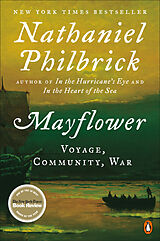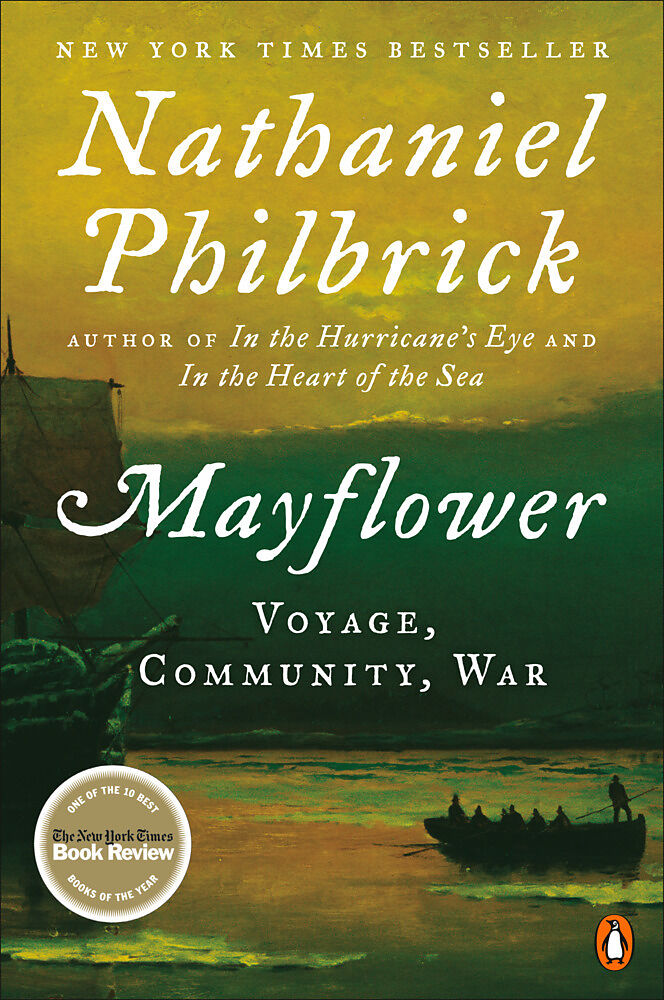Mayflower
Einband:
Kartonierter Einband
EAN:
9780143111979
Untertitel:
Voyage, Community, War
Genre:
Geschichte
Autor:
Nathaniel Philbrick
Herausgeber:
Penguin Publishing Group
Anzahl Seiten:
496
Erscheinungsdatum:
24.04.2007
ISBN:
978-0-14-311197-9
Zusatztext Startling [and] fascinating. ( The New York Times ) Informationen zum Autor Nathaniel Philbrick is the author of In the Heart of the Sea , winner of the National Book Award; Mayflower , finalist for the Pulitzer Prize; Bunker Hill , winner of the New England Book Award; Sea of Glory ; The Last Stand ; Why Read Moby Dick? ; Away Off Shore; Valiant Ambition, and most recently, In the Hurricane's Eye . He lives in Nantucket. Klappentext "Vivid and remarkably fresh...Philbrick has recast the Pilgrims for the ages."-- The New York Times Book Review Finalist for the Pulitzer Prize in History New York Times Book Review Top Ten books of the Year With a new preface marking the 400th anniversary of the landing of the Mayflower. How did America begin? That simple question launches the acclaimed author of In the Hurricane's Eye and Valiant Ambition on an extraordinary journey to understand the truth behind our most sacred national myth: the voyage of the Mayflower and the settlement of Plymouth Colony. As Philbrick reveals in this electrifying history of the Pilgrims, the story of Plymouth Colony was a fifty-five year epic that began in peril and ended in war. New England erupted into a bloody conflict that nearly wiped out the English colonists and natives alike. These events shaped the existing communites and the country that would grow from them. Leseprobe Preface: The Two Voyages We all want to know how it was in the beginning. From the Big Bang to the Garden of Eden to the circumstances of our own births, we yearn to travel back to that distant time when everything was new and full of promise. Perhaps then, we tell ourselves, we can start to make sense of the convoluted mess we are in today. But beginnings are rarely as clear-cut as we would like them to be. Take, for example, the event that most Americans associate with the start of the United States: the voyage of the Mayflower. Wefve all heard at least some version of the story: how in 1620 the Pilgrims sailed to the New World in search of religious freedom; how after drawing up the Mayflower Compact, they landed at Plymouth Rock and befriended the local Wampanoags, who taught them how to plant corn and whose leader or sachem, Massasoit, helped them celebrate the First Thanksgiving. From this inspiring inception came the United States. Like many Americans, I grew up taking this myth of national origins with a grain of salt. In their wide- brimmed hats and buckled shoes, the Pilgrims were the stuff of holiday parades and bad Victorian poetry. Nothing could be more removed from the ambiguities of modern- day America, I thought, than the Pilgrims and the Mayflower. But, as I have since discovered, the story of the Pilgrims does not end with the First Thanksgiving. When we look to how the Pilgrims and their children maintained more than fifty years of peace with the Wampanoags and how that peace suddenly erupted into one of the deadliest wars ever fought on American soil, the history of Plymouth Colony becomes something altogether new, rich, troubling, and complex. Instead of the story we already know, it becomes the story we need to know. In 1676, fifty-six years after the sailing of the Mayflower, a similarly named but far less famous ship, the Seaflower, departed from the shores of New England. Like the Mayflower, she carried a human cargo. But instead of 102 potential colonists, the Seaflower was bound for the Caribbean with 180 Native American slaves. The governor of Plymouth Colony, Josiah Winslow=son of former Mayflower passengers Edward and Susanna Winslow=had provided the Seaflowerfs captain with the necessary documentation. In a certificate bearing his official seal, Winslow explained that these Native men, women, and child...
Startling [and] fascinating. (The New York Times)
Autorentext
Nathaniel Philbrick is the author of In the Heart of the Sea, winner of the National Book Award; Mayflower, finalist for the Pulitzer Prize; Bunker Hill, winner of the New England Book Award; Sea of Glory; The Last Stand; Why Read Moby Dick?; Away Off Shore; Valiant Ambition, and most recently, In the Hurricane's Eye. He lives in Nantucket.
Klappentext
"Vivid and remarkably fresh...Philbrick has recast the Pilgrims for the ages."--The New York Times Book Review
Finalist for the Pulitzer Prize in History
New York Times Book Review Top Ten books of the Year
With a new preface marking the 400th anniversary of the landing of the Mayflower.
How did America begin? That simple question launches the acclaimed author of In the Hurricane's Eye and Valiant Ambition on an extraordinary journey to understand the truth behind our most sacred national myth: the voyage of the Mayflower and the settlement of Plymouth Colony. As Philbrick reveals in this electrifying history of the Pilgrims, the story of Plymouth Colony was a fifty-five year epic that began in peril and ended in war. New England erupted into a bloody conflict that nearly wiped out the English colonists and natives alike. These events shaped the existing communites and the country that would grow from them.
Leseprobe
Preface: The Two Voyages
We all want to know how it was in the beginning. From the Big Bang to the Garden of Eden to the circumstances of our own births, we yearn to travel back to that distant time when everything was new and full of promise. Perhaps then, we tell ourselves, we can start to make sense of the convoluted mess we are in today. But beginnings are rarely as clear-cut as we would like them to be. Take, for example, the event that most Americans associate with the start of the United States: the voyage of the Mayflower. Wefve all heard at least some version of the story: how in 1620 the Pilgrims sailed to the New World in search of religious freedom; how after drawing up the Mayflower Compact, they landed at Plymouth Rock and befriended the local Wampanoags, who taught them how to plant corn and whose leader or sachem, Massasoit, helped them celebrate the First Thanksgiving. From this inspiring inception came the United States. Like many Americans, I grew up taking this myth of national origins with a grain of salt. In their wide- brimmed hats and buckled shoes, the Pilgrims were the stuff of holiday parades and bad Victorian poetry. Nothing could be more removed from the ambiguities of modern- day America, I thought, than the Pilgrims and the Mayflower. But, as I have since discovered, the story of the Pilgrims does not end with the First Thanksgiving. When we look to how the Pilgrims and their children maintained more than fifty years of peace with the Wampanoags and how that peace suddenly erupted into one of the deadliest wars ever fought on American soil, the history of Plymouth Colony becomes something altogether new, rich, troubling, and complex. Instead of the story we already know, it becomes the story we need to know.
In 1676, fifty-six years after the sailing of the Mayflower, a similarly named but far less famous ship, the Seaflower, departed from the shores of New England. Like the Mayflower, she carried a human cargo. But instead of 102 potential colonists, the Seaflower was bound for the Caribbean with 180 Native American slaves. The governor of Plymouth Colony, Josiah Winslow=son of former Mayflower passengers Edward and Susanna Winslow=had provided the Seaflowerfs captain with the necessary documentation. In a certificate bearing his official seal, Winslow explained that these Native men, women, and children had joined in an uprising against the colony and were guilty of 8many notorious and execrable murders, killings, and outrages.e As a consequence, these 8heathen malefactorse had bee…

Leider konnten wir für diesen Artikel keine Preise ermitteln ...
billigbuch.ch sucht jetzt für Sie die besten Angebote ...
Die aktuellen Verkaufspreise von 6 Onlineshops werden in Realtime abgefragt.
Sie können das gewünschte Produkt anschliessend direkt beim Anbieter Ihrer Wahl bestellen.
Loading...
Die aktuellen Verkaufspreise von 6 Onlineshops werden in Realtime abgefragt.
Sie können das gewünschte Produkt anschliessend direkt beim Anbieter Ihrer Wahl bestellen.
| # | Onlineshop | Preis CHF | Versand CHF | Total CHF | ||
|---|---|---|---|---|---|---|
| 1 | Seller | 0.00 | 0.00 | 0.00 |
